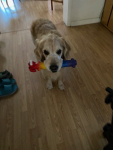SAVE 15% OFF 15% OFF Use Code EPX15 *
Trifexis For Dogs - spinosad|milbenycin oxime - 40.1-60 lbs (1 chewable tablets) - [Heartworm Prevention]
- Notice
- Description
- Ingredients
- Directions
- FAQ
- Reviews
Notices
ON SALE! For a limited time. Add to cart to see automatic coupon. We have the best price and service on the internet.
Description
Trifexis Chewable Tablets for Dogs: Comprehensive Parasite Protection
Trifexis is a popular, once-monthly chewable tablet for dogs, providing broad-spectrum protection against multiple parasites. This prescription medication combines two powerful active ingredients: spinosad for effective flea control and milbemycin oxime for the prevention of heartworm disease and the treatment and control of common intestinal worms (roundworms, hookworms, and whipworms).
Key Benefits of Trifexis for Dogs:
- Broad-Spectrum Protection: Offers comprehensive defense against fleas, heartworms, and key intestinal worms in one convenient monthly chew.
- Convenient Monthly Administration: Palatable chewable tablet is easy for dog owners to give, ensuring consistent protection.
- Rapid Flea Control: Spinosad swiftly kills fleas through nervous system targeting, effectively preventing and treating infestations.
- Heartworm Disease Prevention: Milbemycin oxime prevents potentially life-threatening heartworm disease by eliminating immature heartworm larvae.
- Intestinal Worm Control: Treats and controls roundworms, hookworms, and whipworms, promoting a healthy gastrointestinal system.
Indications:
Trifexis is indicated for:
- Flea Infestation: Treatment and prevention of flea infestations (*Ctenocephalides felis*) through rapid killing of adult fleas and prevention of reinfestation.
- Heartworm Disease: Monthly prevention of heartworm disease (*Dirofilaria immitis*) by eliminating the larval stages.
- Intestinal Parasites: Treatment and control of adult roundworms (*Toxocara canis*, *Toxascaris leonina*), hookworms (*Ancylostoma caninum*, *Uncinaria stenocephala*), and whipworms (*Trichuris vulpis*).
By controlling fleas and certain intestinal parasites, Trifexis may also aid in the prevention of some zoonotic diseases.
How Trifexis Works:
Trifexis chewable tablets combine the power of two active ingredients:
- Spinosad: An insecticide that overstimulates the flea's nervous system, leading to rapid paralysis and death upon ingestion or contact.
- Milbemycin Oxime: An anthelmintic that interferes with nerve transmission in roundworms, hookworms, and whipworms, causing paralysis and elimination.
Administering Trifexis with a full meal enhances the absorption of the active ingredients, ensuring optimal effectiveness. Always follow your veterinarian's recommended dosage based on your dog's weight.
Specifications:
- Brand: Trifexis
- Active Ingredients: Spinosad, Milbemycin Oxime
- Type: Oral chewable tablet
- Indicated for: Prevention of heartworm disease, flea infestations, and treatment/control of roundworms, hookworms, and whipworms in dogs
- Dosage Form: Chewable tablet
- Administration: Administer orally, once a month with a full meal
- Packaging: Available in packs of 6 or 12 tablets
- Storage: Store at room temperature, away from moisture and heat
- Manufacturer: Elanco Animal Health
- Prescription Required: Yes, prescription-only medication. Must be prescribed by a veterinarian.
NADA 141-321
NDC Codes: 58198-4332-6 (Pink), 58198-4333-6 (Orange), 58198-4334-6 (Green), 58198-4335-6 (Blue), 58198-4336-6 (Brown)
Ingredients
| Active Ingredient | Trifexis Pink | Trifexis Orange | Trifexis Green | Trifexis Blue | Trifexis Brown |
|---|---|---|---|---|---|
| Spinosad | 140 mg | 270 mg | 560 mg | 810 mg | 1620 mg |
| Milbemycin Oxime | 2.3 mg | 4.5 mg | 9.3 mg | 13.5 mg | 27 mg |
Directions
Trifexis Chewable Tablets for Dogs: 3-in-1 Parasite Protection
View Trifexis Drug Facts Sheet (PDF)
Trifexis offers convenient, once-monthly, beef-flavored chewable tablets for dogs, providing powerful 3-in-1 protection against heartworm disease, fleas, and common intestinal parasites (adult hookworm, roundworm, and whipworm). This prescription medication combines the effectiveness of spinosad and milbemycin oxime.
Quick Tips for Using Trifexis:
- Administer with food for maximum effectiveness.
- Give once a month.
- Refer to the dosage chart below for the correct tablet for your dog's weight.
- Does not protect against ticks. Consider a separate tick preventative if needed.
- If vomiting occurs within 1 hour of administration, redose with another full dose.
- Consult your veterinarian for pregnant or lactating dogs.
| Dosage Schedule: | |||
|---|---|---|---|
| Body Weight | Spinosad Per Tablet (mg) | Milbemycin oxime Per Tablet (mg) | Tablets Administered |
| 5 to 10 lbs | 140 | 2.3 | One |
| 10.1 to 40 lbs | 270 | 4.5 | One |
| 20.1 to 40 lbs | 560 | 9.3 | One |
| 40.1 to 60 lbs | 810 | 13.5 | One |
| 60.1 to 120 lbs | 1620 | 27 | One |
| Over 120 lbs | Administer the appropriate combination of tablets | ||
Administration Instructions:
Administer Trifexis with food for maximum effectiveness. For heartworm prevention, observe your dog for one hour after dosing. Redose if vomiting occurs within one hour. If a dose is missed by more than a month, administer immediately with food and resume monthly dosing.
Powerful 3-in-1 Parasite Protection:
Just one beef-flavored tablet each month protects your dog against:
- Heartworm disease
- Fleas (starts killing within 30 minutes)
- Intestinal parasites: Adult hookworm* (*Ancylostoma caninum*), roundworm, and whipworm
Is Trifexis Right for Your Dog?
Trifexis is beneficial for dogs who spend time outdoors or live with outdoor pets, as well as indoor dogs that can still be exposed to parasites. The American Heartworm Society (AHS) and the Companion Animal Parasite Council (CAPC) recommend annual testing and year-round heartworm prevention.
Key Threats to Your Dog's Health:

Fleas:
- Provides fast relief, killing fleas within 30 minutes and preventing infestations all month.
- Alleviates discomfort like scratching, chewing, biting, fur loss, and restlessness.
- Helps prevent flea allergy dermatitis (FAD).
- Severe infestations can cause anemia.
Heartworm Disease:
- Transmitted by mosquitoes and reported in all 50 states.
- Symptoms may include coughing, sluggishness, and difficulty breathing, but can be absent.
- Treatment is difficult, costly, and can have complications.
- Untreated, it can be fatal.
Intestinal Parasites:
- Can cause dehydration, anemia, diarrhea, and even death, especially in puppies.
- Dogs can contract them easily from the environment.
Heartworm Prevention:
Administer monthly, starting within 1 month of mosquito exposure and continuing for at least 3 months after the last exposure. Year-round administration is acceptable. When switching preventatives, give the first dose of Trifexis within 1 month of the last dose of the previous medication.
Flea Treatment and Prevention:
Begin treatment anytime, ideally one month before flea season and continue monthly through the end of the season. Year-round treatment is recommended in areas with constant flea activity. Treat all household pets to minimize reinfestation.
Intestinal Nematode Treatment and Control:
Trifexis treats and controls roundworms, hookworms, and whipworms. Advise clients on measures to prevent reinfection.
Contraindications:
There are no known contraindications to the use of Trifexis.
Warnings:
Not for human use. Keep out of reach of children. Serious adverse reactions have been reported following concomitant extra-label use of ivermectin with spinosad alone (a component of Trifexis).
Precautions:
Heartworm testing is recommended prior to use. Treat infected dogs with an adulticide. Use with caution in breeding females and dogs with pre-existing epilepsy. Puppies less than 14 weeks old may experience a higher rate of vomiting.
Adverse Reactions:
The most common adverse reaction reported in clinical trials was vomiting, which was usually mild and self-limiting.
| Average Monthly Rate (%) of Dogs With Adverse Reactions | ||
|---|---|---|
| Adverse Reaction | TRIFEXIS Chewable Tabletsa | Active Control Tabletsa |
| Vomiting | 6.13 | 3.08 |
| Pruritus | 4.00 | 4.91 |
| Lethargy | 2.63 | 1.54 |
| Diarrhea | 2.25 | 1.54 |
| Dermatitis | 1.47 | 1.45 |
| Skin Reddening | 1.37 | 1.26 |
| Decreased appetite | 1.27 | 1.35 |
| Pinnal Reddening | 1.18 | 0.87 |
Storage Information:
Store at 20-25°C (68-77°F), excursions permitted between 15-30°C (59-86°F).
FAQ
Trifexis is indicated to treat and control intestinal parasite infections of adult hookworms, roundworms and whipworms in dogs. In occasional cases, it is possible that you might see intestinal worms being expelled in your dog's stool, this means Trifexis is working. If you have questions, consult your veterinarian for measures you can take to prevent a reinfection of intestinal parasites.
Hookworm (A. caninum), roundworm (T. canis, T. leonina), whipworm (T. vulpis) and tapeworm (T. pisiformis, E. multilocularis, E. granulosus and D. caninum)
Reviews
- It works
- Expensive but they're all expensive.
- Great price
- None
- The EPP staff were great. We had problems getting the Rx approved by my veterinary hospital because their staff failed to carefully look in Ginger's chart to see that her heartworm test was negative within the past year. Once they notified me, I got on the stick to get them to look carefully and worked with the EPP staff to get the faxed Rx appropriately signed. It took patience and perseverance but I have both and so do the EPP staff. All got resolved but they let me know by email and phone so I could get things resolved.
- None
- I got my order
- Can't check my account as the information doesn't update. Didn't come on time. Can never get someone on phone.
- Easy chewable tab. Year round protection given once a month. No side effects for any of our pet dogs.
- Watch for any side effects or allergies. Always check with your vet.
- Easy to give
- Takes care of both fleas and heartworm
- Price
- All medications rolled into one
- Does not taste great, so even though it is a chewable tablet my dog will not eat it.
- Great Product and would recommend Entirely Pets to anyone of my Friends or Family members. I have been using Trifexis for the 2 years I've had my Dog and I've never seen any fleas on her this is a great product and it works well.
- Tracy K.
- The Only downfall to Trifexis is that, if you have ticks in your yard Trifexis doesn't protect against them, other then that it cover everything else.
- Order online instead trip to vet
- Cannot fax or email RX-must mail original












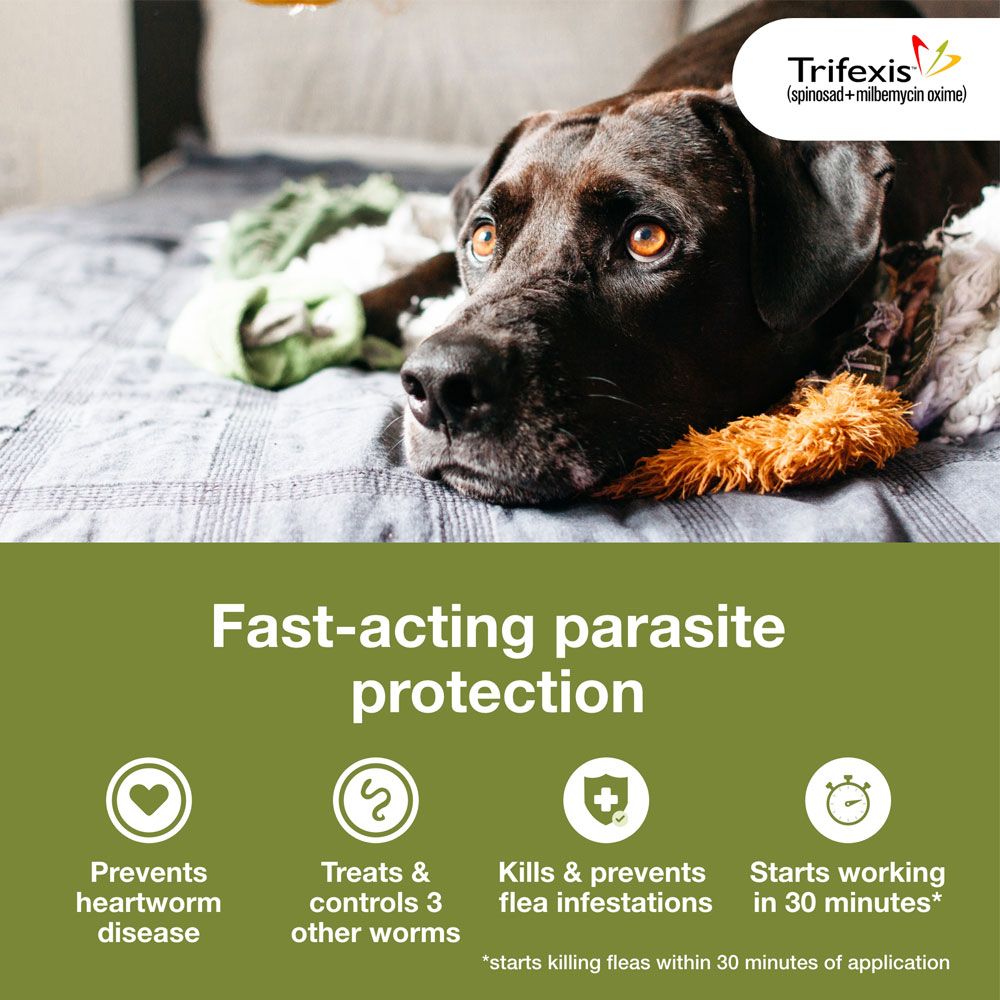
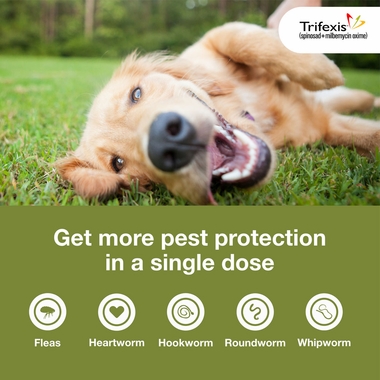
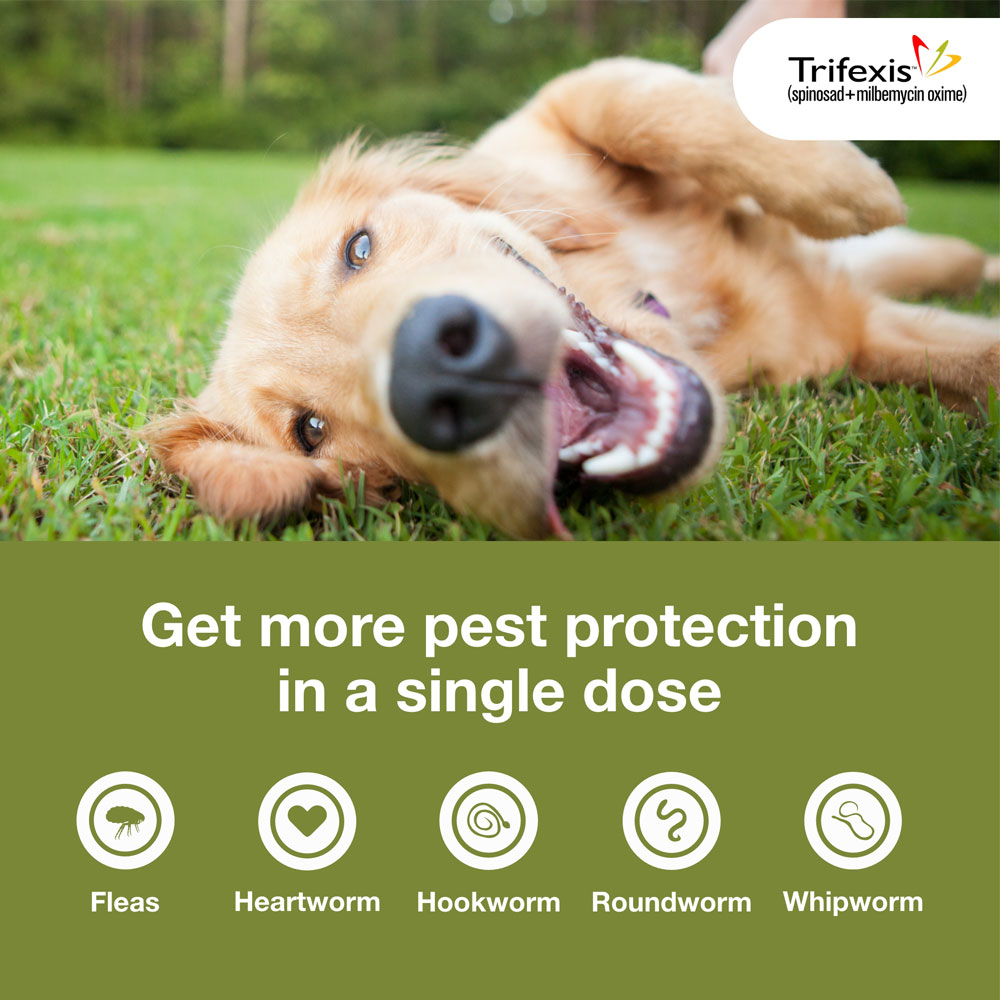
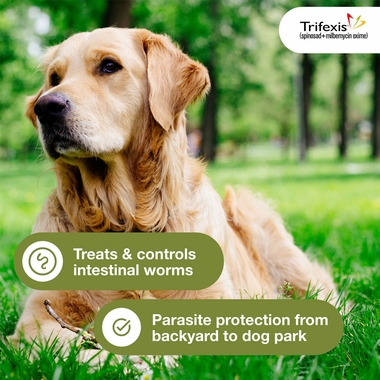
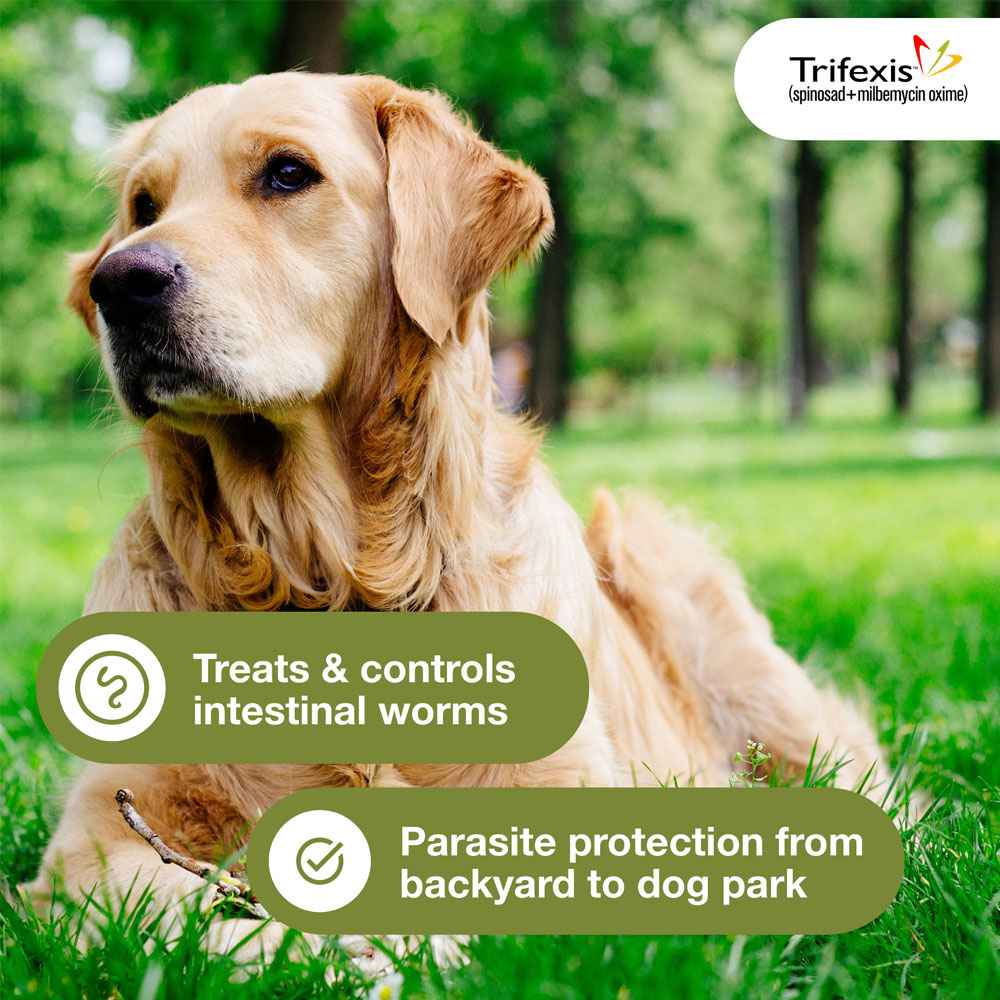
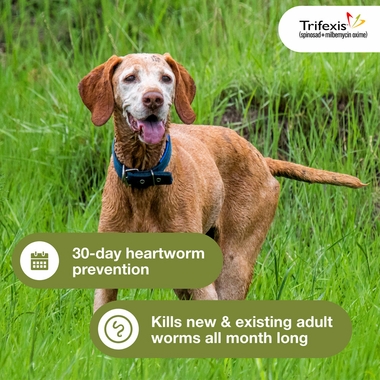
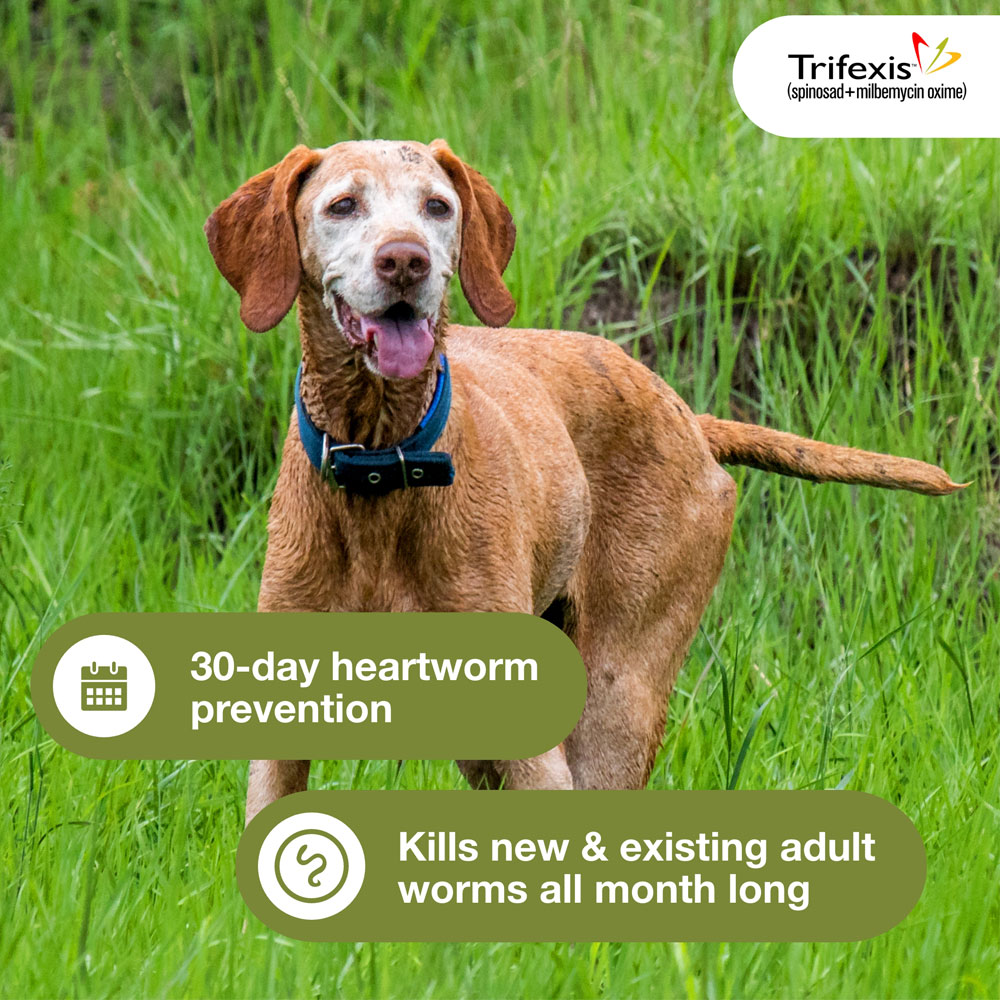






![Trifexis For Dogs - spinosad|milbenycin oxime - 40.1-60 lbs (1 chewable tablets) - [Heartworm Prevention] Video](https://img.youtube.com/vi/r4no5UzPH_4/0.jpg)
